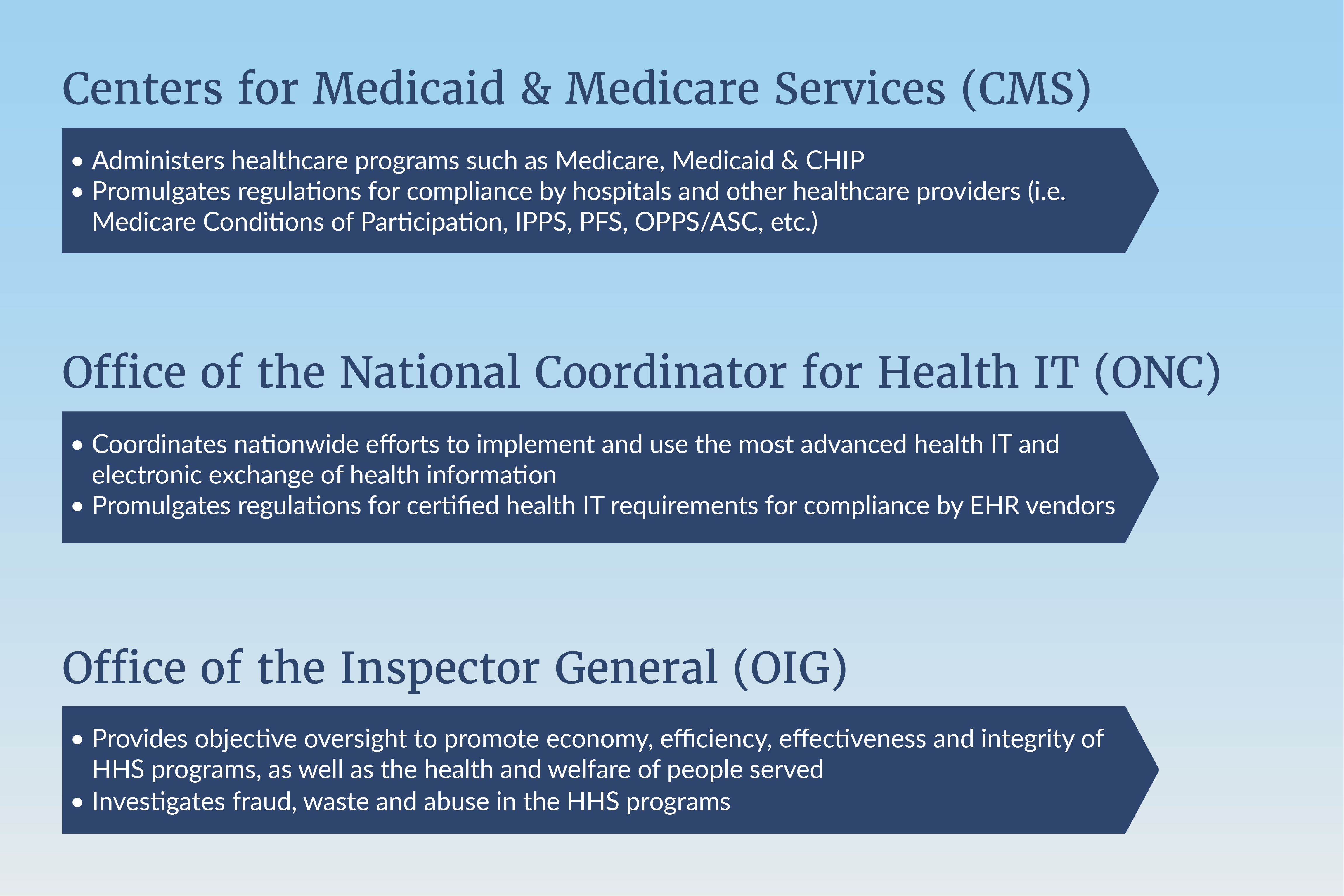As hospitals work to comply with CMS’s patient event notification requirements as part of the Medicare Conditions of Participation (CoPs) within the Interoperability and Patient Access Final Rule, the team at CarePort is receiving several questions regarding the broader regulatory framework, and how the new patient event notification CoPs fit within this existing framework. In this blog post, we provide an overview of the ONC’s 21st Century Cures Act and CMS’s Promoting Interoperability program, and explore how these programs compare to patient event notification CoP requirements.

Patient Event Notification CoP Overview
Hospitals must comply with CMS’s new patient event notification CoPs by May 1, 2021. The CoPs require hospitals to send electronic patient notifications for patient admissions, discharges and transfers to the individual – whether in- or out-of-network – primarily responsible for that patient’s care: the patient’s established primary care provider, the patient’s established primary care practice group, or other practitioners responsible for the patient’s care. Notifications must also be sent to post-acute providers with whom the patient has an established care relationship immediately preceding hospital registration or admission, or those providers to whom the patient is being transferred or referred.
Promoting Interoperability vs. Patient Event Notification CoPs
The Promoting Interoperability Program is a federal program that seeks to expand the use of EHRs in hospitals and physician practices. Previously called “Meaningful Use” or the “EHR Incentive Programs,” CMS renamed the program in 2018 to extend program requirements, with an increased focus on interoperability and improving patient access to health information. Promoting Interoperability states that eligible hospitals or critical access hospitals (CAHs) provide a summary of care record when transitioning or referring patients to another setting of care, receive or retrieve a summary of care record upon the receipt of a transition or referral or upon the first patient encounter with a new patient, and incorporate summary of care information from other providers into their electronic health record (EHR) using the functions of certified EHR technology (CEHRT). When the Promoting Interoperability program started, hospitals, physicians and post-acute providers set up direct mailboxes to enable to the sending of a certain percentage of CCDs electronically via direct message. However, the other percentage of summary of care records could still be faxed. Under either circumstance, Promoting Interoperability does not fulfill new patient event notification CoP requirements.
CMS’s new patient event notification CoPs are not a part of the Promoting Interoperability Program, nor can hospitals demonstrate compliance with patient event notification CoPs simply by participating in Promoting Interoperability. First, these programs differ in how they are measured: there are no measures related to notifications under Promoting Interoperability, which instead focuses on making meaningful use of a certified EHR. Achieving compliance under CMS’s CoPs hinges upon hospitals sending patient event notifications for patient admissions, discharges and transfers to PCPs, physician groups and post-acute providers.
These two programs also differ in the breadth, content and intent of the notifications sent, including (1) the types of notifications sent, (2) the number of providers to which notifications are sent, (3) how notifications are delivered and (4) the intent of the notifications. Notification requirements for patient event notification CoPs are significantly broader – hospitals must notify on admits, transfer and discharge – whereas Promoting Interoperability doesn’t require the transmission of summary care records on admission and transfer. Further, under Promoting Interoperability, CCDs are not necessarily sent to all post-acute providers, as a direct address is required to do so and some post-acute providers do not use an EHR that supports CCDs. Last, although there are no measures related to notifications under Promoting Interoperability, there are care coordination requirements when a patient is discharged from the hospital, or a patient is being discharged or referred to another care setting. As part of that transition, providers must send information regarding that episode of care, which is intended to inform the next provider regarding the patient’s care status (e.g. medications and allergies), and next steps in the patient’s care journey. In summary, Promoting Interoperability requirements cannot fulfill CMS’s patient event notification CoPs – and hospitals must seek alternative solutions to ensure compliance by the May 1, 2021 deadline.
21st Century Cures Act vs. Patient Event Notification CoPs
The 21st Century Cures Act statute, originally passed by the US Congress in 2016, provides the NIH with critical tools and resources to advance biomedical research through programs such as the Cancer Moonshot and the All of Us Research Program. Certain sections addressed interoperability and information blocking, as Congress had concerns that its $30 billion investment in EHR incentive payments were not achieving a sufficient level of interoperability. The 21st Century Cures Act provided the ONC with the authority to develop regulations to improve interoperability and patient access to electronic health information and deter information blocking, and these provisions are widely applicable across the healthcare industry – including healthcare providers (hospitals), health IT vendors, HIEs and HINs.
Though CMS’s Interoperability and Patient Access Final Rule and the ONC’s Interoperability, Information Blocking, and the ONC Health IT Certification Program final rule were released on the same day to demonstrate a coordinated federal effort, they are not the same program. However, they are parallel, or complementary, to one another, and both enact a vision from the 21st Century Cures Act. A Medicare CoP, however, is a very different kind of regulation. CoPs set the bar for the deliverables a hospital must achieve in order to provide care for Medicare beneficiaries, and more importantly to be reimbursed for providing that care.
Learn how CarePort’s interoperability solution can help your organization comply with CMS’s patient event notification CoPs, or contact us for more information.